Neanderthals may have cut off the toes of imperial eagles, an endangered species, to use their claws to make necklaces.
Cut marks on the eagle’s toe bone. Photo: IFL Science.
A team of experts found the eagle’s left toe bone in Foradada cave, Calafell, since 2015. After research, they believe that this bone is about 40,000 years old, much newer than other samples. Similar objects were found. discovered previously.
The Neanderthal custom of using claws as jewelry began to spread in southern Europe about 120,000 years ago. The bones in Foradada Cave were used during the late Neanderthal period, before this group became extinct. This is the latest trace showing that Neanderthals used claws as jewelry and is also the first time such traces have been found on the Iberian Peninsula.
This new discovery is one of the rare pieces of evidence that ancient people used animal parts as symbolic objects rather than for practical purposes. It also contributes to showing the complex cultural life of Neanderthals. Experts have found eagle claws in parts of Europe where Neanderthals once lived. Some previous research also showed that this ancient group of people may have used marine animal shells as beads to express social status.
The team used 3D computer modeling to analyze cut marks on the bones. They discovered that they had man-made traces, meaning they were influenced by ancient people’s tools. According to Antonio Rodriguez-Hidalgo, a researcher at the African Institute of Evolution, this may be the last necklace made by Neanderthals.
Juan Ignacio Morales, co-author of the study, said that the use of eagle claws as decoration may be a cultural transfer from Neanderthals to modern humans. Modern people adopted this custom after arriving in England.
Experts have discovered toe bones of birds of prey in many locations where Neanderthals lived in ancient times. The oldest specimens were found in Croatia, dating back about 130,000 years ago, before the appearance of modern humans. They are now considered the oldest iconic Neanderthal artifacts.



